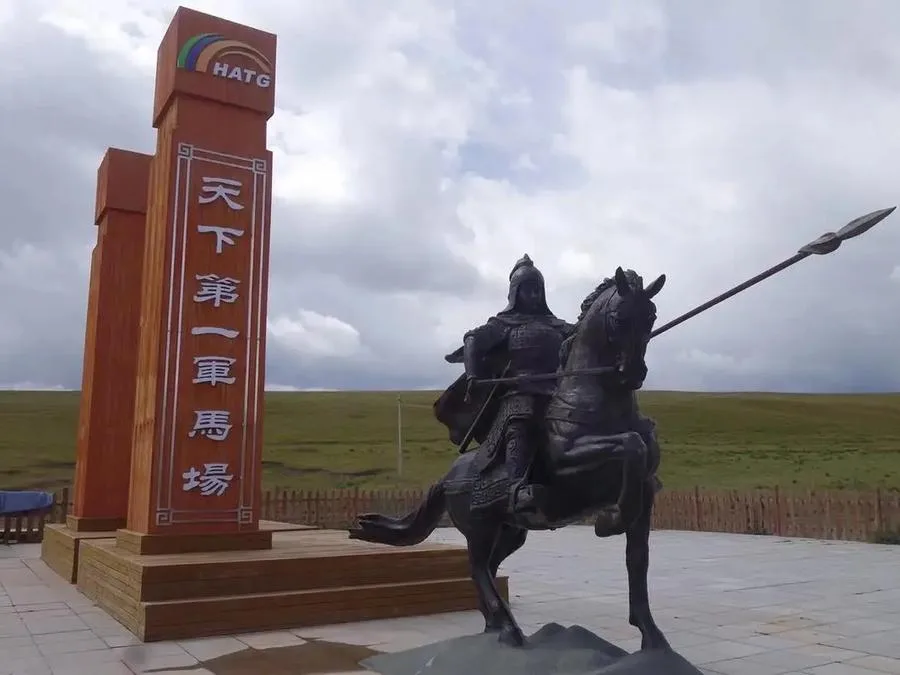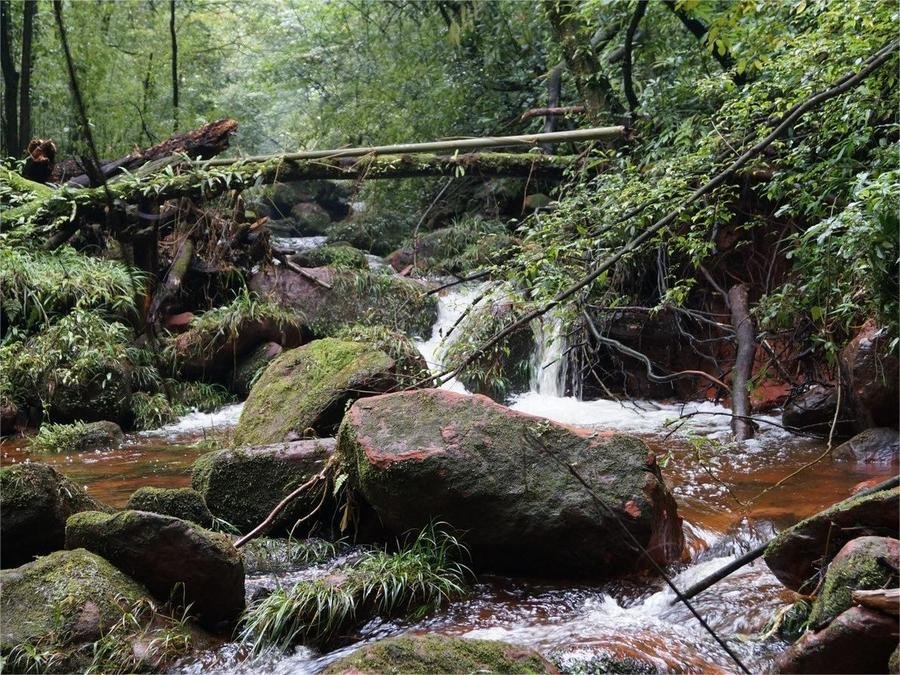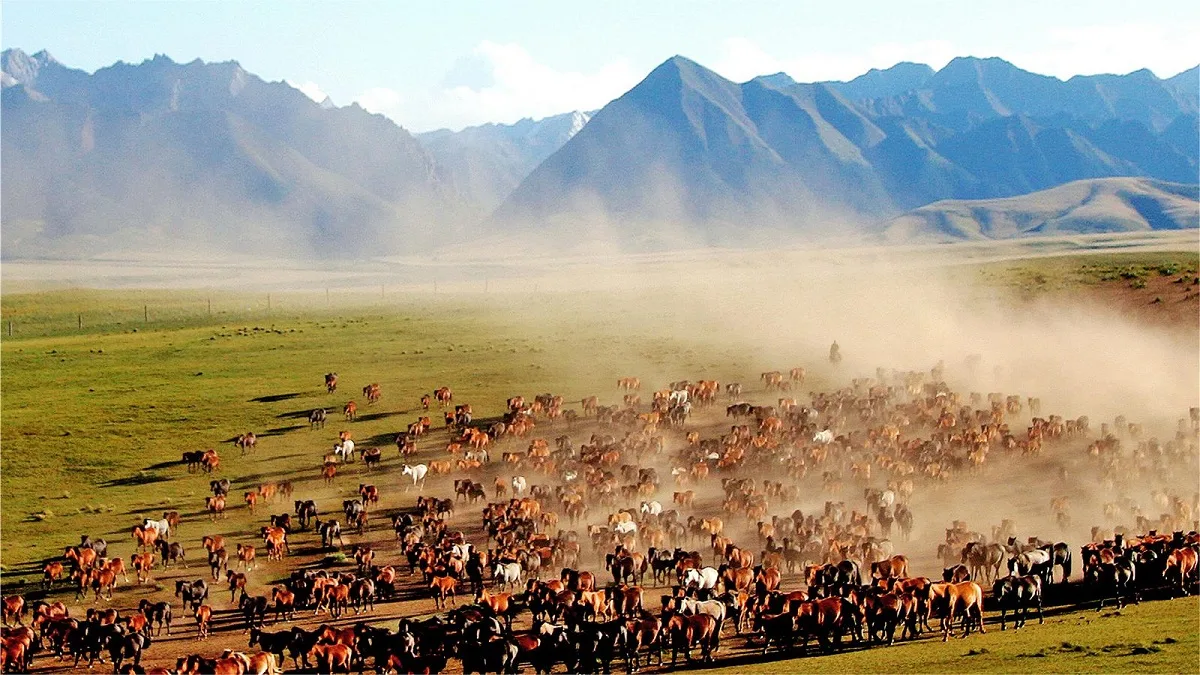Shandan Military Horse Farm (山丹军马场), founded in 121 BCE by General Huo Qubing of the Western Han Dynasty, is located in the central part of the Hexi Corridor. Nestled in the northern foothills of the Lenglong Range of the Qilian Mountains, this expansive grassland, known as Dama Ying, spans across Gansu and Qinghai provinces, adjacent to six counties and three cities (or prefectures). Covering a vast area of 3.2954 million acres, the farm’s flat terrain, lush grass, and abundant water make it an ideal location for horse breeding and growth.
Recognized by “China Geography” magazine as one of China’s six most beautiful grasslands, Shandan Military Horse Farm is both historically significant and scenically stunning. It is the oldest royal horse farm in the world. It was once Asia’s largest and the world’s second-largest military horse farm. After the dissolution of the Soviet Union’s Don Horse Farm, Shandan Military Horse Farm claimed the title of the world’s largest horse farm.
The farm is divided into several sections, including the main farm and five subsidiary areas. Each area offers unique attractions, with the third section being renowned for its grand and beautiful landscapes. The primary tourist areas, including hotels and restaurants, are concentrated in the first section. The travel distance between these two sections is approximately two hours by car. Visitors typically start their journey at the third section, enjoying its picturesque natural scenery before heading to the first section for an overnight stay. The next day, visitors can indulge in horse riding activities before departing through Shandan County.
Apart from its majestic landscapes and historical significance, Shandan Military Horse Farm also offers a variety of local delicacies. Wild mushrooms, specialty lake fish, yogurt, and honey are some of the farm’s culinary highlights, providing a delightful experience for visitors.
Table of Contents
- Basic Information
- Location and Transportation
- Highlights of Shandan Military Horse Farm
- Vlog about Shandao Horse Farm
- History of Shandan Military Horse Farm
- Other Attractions in Southern Zhangye
Basic Information
| Estimated Length of Tour | 1 day |
| Ticket Price | Free |
| Opening Hours | 8.30 – 17.30 |
| Telephone Number | 0086-0936-2881818 0086-0936-2891022 |
Location and Transportation
Shandan Military Horse Farm is located in the Damaying Grassland (大马营草原) of Shandan County, Zhangye City, Gansu Province. To get there, you can take a bus from Zhangye East Bus Station to Shandan, with buses running every half hour. There are also direct buses to the horse farm in the afternoon. The farm is divided into several sections, with Section One being the farthest. For convenience, consider hiring a car for about 250 yuan, negotiable. The farm has guesthouses that are clean and well-equipped.
Highlights of Shandan Military Horse Farm
Diverse Breeds of Horses

Shandan Military Horse Farm boasts a rich history of horse breeding that dates back over 3,000 years. The farm’s flat terrain and lush pastures, particularly vibrant with blooming canola and wildflowers during the summer, provide an ideal environment for horse rearing. Since the Western Han Dynasty, the farm has been a breeding ground for various superior horse breeds, based initially on local Mongolian horses. Over time, these horses were crossbred with high-quality horses from the Western Regions, resulting in the renowned Shandan horses.
Shandan horses are known for their well-proportioned, robust, and muscular build, combining speed and endurance, making them excellent riding horses. Today, the farm is home to over 10,000 horses. Visitors can enjoy a range of equine activities, including watching horse races and equestrian performances, as well as participating in horseback riding and camping. Galloping through the flower-filled meadows on horseback offers an exhilarating experience.
Kulong Gorge Scenic Area

Located southeast of the first section of the Shandan Military Horse Farm, the Kulong Gorge Scenic Area features unique geological formations. The landscape is characterized by traps-like “holes” scattered across the verdant grasslands within the gorge. Crystal-clear streams weave through the crevices of massive rocks, creating a melodic symphony. Even when walking on the riverbank grasslands without visible “holes,” the sound of underground streams gurgling can be heard beneath your feet.
During the summer, Kulong Gorge is adorned with lush cypress and pine trees, an abundance of wildflowers, and a flurry of butterflies and bees, creating a serene and picturesque setting. The air is filled with the refreshing fragrance of green grass. A swift brook cascades through the valley, adding to the enchanting atmosphere. Visitors can either leisurely stroll or ride horses through the gorge, accompanied by fluttering butterflies and cooled by the gentle breeze, offering a uniquely enjoyable experience.
General’s Stone Scenic Area

The General’s Stone Scenic Area is a breathtaking part of Kulun Gorge, known for its dramatic and picturesque landscape. High peaks rise on either side of the gorge, their rugged outlines creating an interplay of harshness and beauty. Amidst these diverse and striking mountains stands a magnificent, naturally sculpted boulder known as “General’s Stone.”
Legend has it that in 121 BC, during the second year of Emperor Wu of Han‘s reign, a young and skilled general named Huo Qubing led 5,000 elite cavalry from Longxi, through Qinghai, across the Qilian Mountains, and into the heart of the Huns’ territory. After a fierce battle on the expansive Yanzhi grassland, Huo Qubing emerged victorious. Celebrating his triumph, he hosted a grand banquet for his army in the stunning surroundings of Kulun Gorge. In a moment of reflection, he stood atop one of the peaks, plunged his sword into the stone, and marveled at the boundless pastures and majestic scenery. He declared this place an ideal site for raising war horses, and thus a fort was established there with imperial approval.
Tragically, Huo Qubing passed away at the young age of 24. On the day of his death, it is said that a massive storm struck the Qilian Mountains, causing landslides and altering the landscape dramatically. When the storm cleared, a towering rock resembling the general himself appeared at the spot where he had stood, believed to be his spirit turned to stone, eternally guarding the land and its people.
Dahuanggou Canyon Forest Scenic Area

Located within the fourth section of the Shandan Military Horse Farm, the Dahuanggou Canyon Forest Scenic Area is named after the valuable medicinal herb, rhubarb, which grows abundantly here. This area is a significant tributary of the West Dahu River, featuring a stunning canyon forest landscape. Stretching from northeast to southeast, it borders Yongchang County to the northeast and Subei Mongol Autonomous County to the southeast.
The region experiences a cold, semi-humid climate, with sunlit slopes covered in shrub forests and shady slopes blanketed in dense forest. The area is home to an ancient forest, where towering trees block out the sun, and the air is filled with the songs of birds and the fragrance of flowers. The West Dahu River flows swiftly through the canyon, creating a series of rapids and waterfalls that enhance the area’s natural beauty. Often referred to as the “Jiuzhaigou of Qilian,” Dahuanggou Canyon Forest Scenic Area is an ideal destination for nature lovers, offering a perfect escape from the hustle and bustle of city life.
Horse Racing Festival

Since the 1950s, Shandan Military Horse Farm has hosted an impressive Horse Racing Festival every year on August 1st, coinciding with Army Day. This grand event features thrilling horse races and equestrian performances, attracting thousands of workers and local residents from neighboring counties. Attendance can range from a few thousand to tens of thousands, with festivities lasting 3 to 5 days. Over time, the festival has evolved into a comprehensive celebration, incorporating horse racing, equestrian shows, sports competitions, cultural performances, and trade fairs. This iconic event showcases the rich heritage and vibrant community spirit of the region.
Vlog about Shandao Horse Farm
History of Shandan Military Horse Farm
Han Dynasty: In 121 BCE, General Huo Qubing of the Han Dynasty led his cavalry through the Hexi Corridor, including the Dama Ying Grassland, to defeat the Xiongnu tribes. This victory secured the region, and the Xiongnu’s lament—”Losing my Qilian Mountains, my livestock will not flourish; losing my Yanzhi Mountain, my women will lose their beauty”—echoes through history.
Northern Wei Dynasty: In 439 CE, Emperor Taiwu of the Northern Wei Dynasty unified the north, including the Hexi Corridor. During this period, the Dama Ying Grassland expanded significantly, supporting up to 2 million horses and 1 million camels, alongside countless cattle and sheep.
Sui Dynasty: In 609 CE, Emperor Yang of the Sui Dynasty visited the area and ordered the establishment of an official horse breeding farm on the Dama Ying Grassland. This marked the beginning of organized horse breeding in the region.
Tang Dynasty: Under the Tang Dynasty, Emperor Taizong appointed Zhang Jingshun to oversee horse breeding. At its peak, the farm housed over 70,000 horses, significantly contributing to the empire’s cavalry strength.
Qing Dynasty: By 1801, the farm had 18,000 horses. This number grew to 20,000 by 1838. However, the late Qing Dynasty saw political turmoil, reducing the number of horses to a few hundred.
Republic of China: In 1919, the military government appointed Yu Kuiwu as the farm manager. However, frequent wars led to the farm’s decline. By 1929, it became a private ranch for warlords Ma Bufang and Ma Buqing. It wasn’t until 1940 that the central government reclaimed the farm.
People’s Republic of China: In 1949, the farm was officially taken over by the People’s Liberation Army. Renamed multiple times, it ultimately became the ShanDan Military Horse Farm, managed by the PLA General Logistics Department. In 2001, the farm was transferred to China Animal Husbandry Group, marking a new era of management and development.




